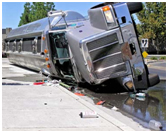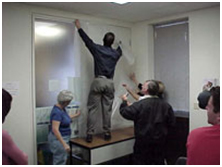 There are different emergency situations that could require sheltering-in-place, some of which include hazardous materials spills, tornadoes, pandemic flu outbreaks, winter storms, active shooter situations or a terrorist attacks. Most of us know to go to the basement when there's a tornado, and to close the doors to keep in heat during the winter. But would you know what to do if a dangerous chemical is released or spilled in your neighborhood?
There are different emergency situations that could require sheltering-in-place, some of which include hazardous materials spills, tornadoes, pandemic flu outbreaks, winter storms, active shooter situations or a terrorist attacks. Most of us know to go to the basement when there's a tornado, and to close the doors to keep in heat during the winter. But would you know what to do if a dangerous chemical is released or spilled in your neighborhood?
Hazardous chemicals are all around us. They are used in factories, on farms, and are transported on our highways and rail lines. They can be solids, liquids or gases. While some can be seen and smelled, others may be invisible or odor free. If a hazardous chemical is spilled or released into the air — either accidentally or with criminal intent — you may need to take protective actions until the spill is cleaned up or the gas cloud blows away. In situations that require sheltering in place, you will be notified by the authorities in your community. Yet if you hear an explosion, see a large smoke or vapor cloud, or notice an unusual smell, call 9-1-1. Listen to local TV and radio news broadcasts, or your NOAA all-hazards weather radio for instructions.
 If you are told to Shelter-in-Place:
If you are told to Shelter-in-Place:
- Take action immediately
- Go inside. Bring pets inside.
- Close and lock all exterior doors and windows. Close vents, fireplace dampers, and as many interior doors as possible.
- Turn off heating, air conditioners, and close any fireplace dampers and ventilation systems. In large buildings, set ventilation systems to 100 percent recirculation so that no outside air is drawn into the building. If this is not possible, ventilation systems should be turned off.
- Gather people and pets into the pre-chosen shelter room. This room should be above ground and have the fewest openings to the outside.
- Seal gaps under doorways and windows with wet towels or plastic sheeting and duct tape.
- Seal gaps around window and air conditioning units, bathroom and kitchen exhaust fans, and stove and dryer vents with duct tape and plastic sheeting, wax paper or aluminum wrap.
- Use material to fill cracks and holes in the room, such as those around pipes.
- If gas or vapors could have entered the building, take shallow breaths through a cloth or a towel. Avoid eating or drinking any food or water that may be contaminated.
- Ten square feet of floor space per person will provide sufficient air to prevent carbon dioxide build-up for up to five hours, assuming a normal breathing rate while resting.
- However, local officials are unlikely to recommend the public shelter in a sealed room for more than 2-3 hours because the effectiveness of such sheltering diminishes with time as the contaminated outside air gradually seeps into the shelter. At this point, evacuation from the area is the better protective action to take.
- Also you should ventilate the shelter when the emergency has passed to avoid breathing contaminated air still inside the shelter.
- Keep listening to radio or TV for an "all clear" or further instructions.
For more information on Shelter-in-Place procedures, visit http://www.ready.gov/hazardous-materials-incidents.




